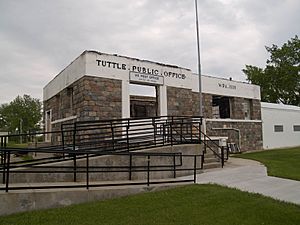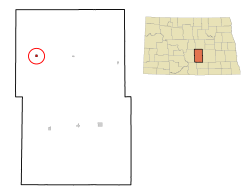Tuttle, North Dakota facts for kids
Quick facts for kids
Tuttle, North Dakota
|
|
|---|---|

Tuttle Public Office - Tuttle
|
|

Location of Tuttle, North Dakota
|
|
| Country | United States |
| State | North Dakota |
| County | Kidder |
| Area | |
| • Total | 0.25 sq mi (0.64 km2) |
| • Land | 0.25 sq mi (0.64 km2) |
| • Water | 0.00 sq mi (0.00 km2) |
| Elevation | 1,850 ft (560 m) |
| Population
(2020)
|
|
| • Total | 60 |
| • Density | 241.94/sq mi (93.23/km2) |
| Time zone | UTC-6 (CST) |
| • Summer (DST) | UTC-5 (CDT) |
| ZIP code |
58488
|
| Area code(s) | 701 |
| FIPS code | 38-80140 |
| GNIS feature ID | 1036302 |
Tuttle is a small city in Kidder County, North Dakota, in the United States. In 2020, about 60 people lived there. Tuttle was started in 1911.
Around the time Tuttle was founded, many families from German-Russian backgrounds moved to the area. They claimed land under the Homestead Act, which let people get land from the government if they lived on it and farmed it. Many of their family members still farm and ranch near Tuttle today.
Contents
About Tuttle's Location
Tuttle is a small city, covering about 0.25 square miles (0.64 square kilometers) of land. It is located in a special area called the Prairie Pothole Region. This area has many small wetlands, which are like natural ponds. It is also part of the Central Flyway, a major path that many birds use when they migrate. Because of this, Tuttle is a popular spot for people who enjoy hunting waterfowl, like ducks and geese.
Tuttle's History
Tuttle was named after a man named Colonel William P. Tuttle. He worked for a company that planned out towns. The company mapped out Tuttle in 1910. Colonel Tuttle never actually lived in Tuttle, but he liked the town. He even bought baseball uniforms for the local team!
Early Days and the Railroad
The Northern Pacific Railway built train tracks through Tuttle on October 4, 1911. Train service began later that month, connecting Tuttle to a town called Pingree. The railroad was very important for the town's growth.
Fires and Community Spirit
On January 21, 1917, a big fire destroyed the Miller General Store and other businesses in Tuttle. But the town's citizens worked together to save other buildings from the flames. After this fire, people decided to create a volunteer fire department. This fire department still helps the town today! J.W. Wittmayer was chosen as Tuttle's first fire chief.
Weather Challenges in Tuttle
Life in Tuttle has always involved facing tough weather. Winters can bring very cold temperatures and huge snowstorms called blizzards. Summers can be very hot with strong storms.
One memorable storm happened on July 3, 1935. A strong wind blew, and then hail and heavy rain fell. This caused a lot of damage. Almost every window facing north and west in homes and businesses was broken. Even with the damage, the town still held its Independence Day celebration the next day.
On July 1, 1952, a tornado hit Tuttle in the evening. People said the sky looked very scary. As the tornado got closer, residents heard a sound like "hundreds of freight trains." The tornado damaged several homes, but many others were not affected.
Recent Changes in Tuttle
The year 2007 was a difficult time for Tuttle. The Tuttle School closed down, and an old hotel landmark, the Danielson Hotel, was taken down.
On November 19, 2007, the Tuttle post office building was badly damaged by a fire. This building was historic, built in 1938 as a project by the WPA, a government program. The fire caused a lot of smoke that could be seen for miles. Luckily, the strong stone and concrete walls of the building were not destroyed. The post office was rebuilt and reopened by 2011.
Like many small towns in the North American Great Plains, Tuttle has seen many businesses close over the years. Young people often move to bigger cities, which means the town's population is getting older. Today, Tuttle does not have a bank, a school, or a newspaper. However, it still has a well-stocked grocery store and a grain elevator, which is a building used to store grain.
Even though the train tracks were removed around 2004, better roads and access to Interstate 94 have made Tuttle less isolated. Larger cities like Bismarck and Jamestown are only about an hour's drive away. This makes it easier for Tuttle residents to reach bigger towns for shopping and services.
Tuttle's Population
| Historical population | |||
|---|---|---|---|
| Census | Pop. | %± | |
| 1920 | 321 | — | |
| 1930 | 383 | 19.3% | |
| 1940 | 357 | −6.8% | |
| 1950 | 368 | 3.1% | |
| 1960 | 255 | −30.7% | |
| 1970 | 216 | −15.3% | |
| 1980 | 202 | −6.5% | |
| 1990 | 160 | −20.8% | |
| 2000 | 106 | −33.7% | |
| 2010 | 80 | −24.5% | |
| 2020 | 60 | −25.0% | |
| 2021 (est.) | 59 | −26.2% | |
| U.S. Decennial Census 2020 Census |
|||
The population of Tuttle has changed over the years. In 2010, there were 80 people living in the city. Most of the people living in Tuttle were White.
There were 43 households in 2010. A household is a group of people living together. About 7% of households had children under 18. Many households were made up of individuals living alone, especially people aged 65 or older. The average age of people in Tuttle in 2010 was about 59 years old.
Tuttle's Climate
Tuttle has a type of weather called a humid continental climate. This means it has big differences in temperature between seasons. Summers are usually warm to hot, and sometimes humid. Winters are cold, and can be very cold.
See also
 In Spanish: Tuttle (Dakota del Norte) para niños
In Spanish: Tuttle (Dakota del Norte) para niños

